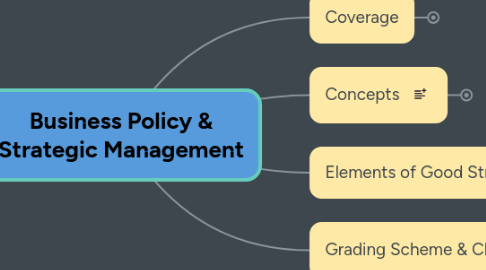
1. Coverage
1.1. a. Corporate Governance
1.2. b. Environmental Scanning
1.2.1. a. External Environmental Scanning & Industry Analysis
1.2.2. b. Internal Scanning
1.3. c. Strategy Formulation
1.3.1. a. Situation Analysis & Business Strategy
1.3.2. b. Corporate Strategy
1.3.3. c. Functional Strategy & Strategic Choice
1.4. d. Strategy Implementation
1.4.1. a. Organizing for Action
1.4.2. b. Staffing & Directing
1.5. e. Evaluation & Control
1.6. f. Strategic Issues
1.6.1. a. Managing Technology and Innovation
1.6.2. b. Entrepreneurial Ventures and Small Businesses
1.6.3. c. Not-For-Profit Organizations
2. Concepts
2.1. Attributes
2.1.1. Organizational directing
2.1.2. Participative decision-making
2.1.3. Short- and Long-Term perspectives
2.1.4. Efficiency and Effectiveness tradeoffs
2.2. Benefits
2.2.1. Clearer sense of strategic vision
2.2.2. Improved understanding of changing environment
2.3. Business Policy
2.4. Challenges
2.4.1. Global Strategic Issues
2.4.2. E-Commerce
2.4.3. Strategic Flexibility
2.4.3.1. Adaptation to Changing Environmental Conditions
2.4.3.2. Long-term commitment to development & nurturing of critical resources
2.4.3.3. Demands that the firm become a learning organization
2.4.3.3.1. Solving problems systematically
2.4.3.3.2. Experimenting with new approaches
2.4.3.3.3. Learning from their own experiences and that of others
2.4.3.3.4. Transferring knowledge quickly and efficiently throughout the organization
2.5. Elements
2.5.1. Processes
2.5.1.1. Analyzing
2.5.1.2. Decision-making
2.5.1.3. Implementing
2.5.2. Key Questions
2.5.2.1. How to create competitive advantage
2.5.2.2. How to sustain competitive advantage
2.6. Emergent Strategy
2.6.1. Mintzberg
2.7. Evolution
2.7.1. Basic Financial Planning
2.7.2. Forecast based planning
2.7.3. Externally oriented planning
2.7.4. Strategic Management
2.8. Quick SM
2.8.1. Where is the organization now
2.8.2. If no change, where will the organization be in 1, 2, 5, 10 years
2.8.3. What specific actions should management undertake
2.8.4. What are the risks and payoffs involved
2.9. Responsibilities
2.9.1. Operational
2.9.1.1. Actions/ plans <1year
2.9.2. Strategic
2.9.2.1. > 1 year, future orientation
2.9.2.2. Often crowded out by operational work
2.10. SM Model
2.10.1. Environmental Scanning
2.10.1.1. External
2.10.1.2. Internal
2.10.2. Strategy Formulation
2.10.2.1. Mission
2.10.2.2. Objectives
2.10.2.3. Strategies
2.10.2.4. Policies
2.10.3. Strategy Implementation
2.10.3.1. Programs
2.10.3.2. Budgets
2.10.3.3. Procedures
2.10.4. Evaluation & Control
2.10.4.1. Performance monitoring
2.10.4.2. Corrective actions
2.10.5. Feedback / learning
